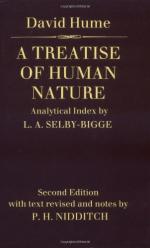This argument affects not the question concerning the substance of the soul, but only that concerning its local conjunction with matter; and therefore it may not be improper to consider in general what objects are, or are not susceptible of a local conjunction. This is a curious question, and may lead us to some discoveries of considerable moment.
The first notion of space and extension is derived solely from the senses of sight and feeling; nor is there any thing, but what is coloured or tangible, that has parts disposed after such a manner, as to convey that idea. When we diminish or encrease a relish, it is not after the same manner that we diminish or encrease any visible object; and when several sounds strike our hearing at once, custom and reflection alone make us form an idea of the degrees of the distance and contiguity of those bodies, from which they are derived. Whatever marks the place of its existence either must be extended, or must be a mathematical point, without parts or composition. What is extended must have a particular figure, as square, round, triangular; none of which will agree to a desire, or indeed to any impression or idea, except to these two senses above-mentioned. Neither ought a desire, though indivisible, to be considered as a mathematical point. For in that case it would be possible, by the addition of others, to make two, three, four desires, and these disposed and situated in such a manner, as to have a determinate length, breadth and thickness; which is evidently absurd.
It will not be surprising after this, if I deliver a maxim, which is condemned by several metaphysicians, and is esteemed contrary to the most certain principles of hum reason. This maxim is that an object may exist, and yet be no where: and I assert, that this is not only possible, but that the greatest part of beings do and must exist after this manner. An object may be said to be no where, when its parts are not so situated with respect to each other, as to form any figure or quantity; nor the whole with respect to other bodies so as to answer to our notions of contiguity or distance. Now this is evidently the case with all our perceptions and objects, except those of the sight and feeling. A moral reflection cannot be placed on the right or on the left hand of a passion, nor can a smell or sound be either of a circular or a square figure. These objects and perceptions, so far from requiring any particular place, are absolutely incompatible with it, and even the imagination cannot attribute it to them. And as to the absurdity of supposing them to be no where, we may consider, that if the passions and sentiments appear to the perception to have any particular place, the idea of extension might be derived from them, as well as from the sight and touch; contrary to what we have already established. If they appear not to have any particular place, they may possibly exist in the same manner; since whatever we conceive is possible.




